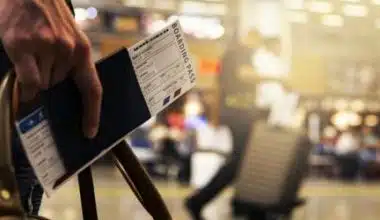Have you ever wondered about the rules and regulations surrounding bringing food on an airplane? Let’s explore the guidelines, tips, and considerations when it comes to carrying food with you during your flight. Food can be brought on an airplane, but certain rules must be followed. Solid food items can be transported in carry-on or checked bags, while liquid or gel food items larger than 3.4 oz are not allowed. Baby food and milk formula are allowed in reasonable quantities, and special dietary needs can be met with a doctor’s note or medical documentation.
Can You Bring Food On An Airplane?
Food can be brought on an airplane, but certain rules and exceptions must be followed. These rules include
#1. Solid Food Items
Solid food items (not liquids or gels) can be transported in either your carry-on or checked bags. Meat, seafood, and other non-liquid food items are permitted in both carry-on and checked bags. The TSA approves of bringing solid, fresh foods in carry-ons and clears fresh fruits and vegetables in checked bags.
#2. Liquid or Gel Food Items
Liquid or gel food items larger than 3.4 oz. are not allowed in carry-on bags. If the food is packed with ice or ice packs in a cooler or other container, the ice or ice packs must be completely frozen when presented for TSA screening. Liquid foods are frozen solids when presented for screening; they can be brought through airport security. If frozen food or drinks are partially melted or slushy, they must meet the 3.4-ounce liquid sizing requirements to be allowed through security in carry-on bags.
#3. Baby Food and Formula
Baby food and formula are allowed in reasonable quantities in carry-on bags. These items may need to be screened separately from the rest of your belongings at the security checkpoint. It’s a good idea to inform the security officers that you have baby food or formula in your bag to facilitate the screening process.
#4. Special Dietary Needs
If you have special dietary needs due to medical conditions or allergies, you are generally allowed to bring food items that meet your dietary requirements. It’s recommended to carry a doctor’s note or medical documentation to support your need for these items.
#5. Post-security
Once you make it through security, the size of liquid food and drink items is no longer a concern, as bringing food and liquids purchased post-security is allowed. You can bring coffee on a plane after security, as well as take-away meals or other snacks. All larger liquid or gel items, as well as food purchased after you’ve cleared the TSA checkpoint, can be brought on board.
The Food You Cannot Bring on a Plane.
When it comes to bringing food on an airplane, certain food items are generally not allowed or have restrictions. Examples include
#1. Large Quantities of Food
Bringing large quantities of food, especially for commercial purposes, may be subject to additional regulations and restrictions. It’s recommended to check with the relevant authorities or airline for specific guidelines.
#2. Fresh Produce and Meat Products
Some countries have restrictions on bringing fresh produce or meat products due to agricultural and customs regulations. It’s important to review the customs regulations of your destination country before packing these items.
#3. Alcohol
The rules for bringing alcohol on an airplane can vary. In general, alcoholic beverages with an alcohol content above 70 percent are not allowed in carry-on or checked bags. Alcoholic beverages with an alcohol content between 24 and 70 percent are typically allowed in checked bags, but there may be limits on the quantity. It’s best to check with your airline and review the specific regulations.
#4. Absinthe
The importation of Absinthe is subject to specific regulations, including restrictions on thujone content, labeling requirements, and artwork restrictions. Absinthe imported in violation of these regulations may be subject to seizure.
#5. Liquids and Gels
The Transportation Security Administration (TSA) has restrictions on bringing liquids and gels in containers larger than 3.4 ounces (100 milliliters) in carry-on bags. This includes items like soups, sauces, yogurt, and beverages. It’s best to pack these items in your checked bags or purchase them after the security checkpoint.
Packaging Tips For Bringing Food On An Airplane
These are tips on how to properly package food for airplane transportation, ensuring its convenience, safety, and compliance with security regulations.
#1. Use Secure Containers
Pack your food in sturdy, leak-proof containers to prevent spills and avoid contamination. Consider using containers with tight-fitting lids or resealable bags to keep your food fresh and contained.
#2. Separate Liquids and Gels
If you’re bringing liquids or gels, such as sauces or dressings, ensure they comply with the TSA’s 3-1-1 rule. Place them in containers of 3.4 ounces (100 milliliters) or less and pack them in a clear, quart-sized plastic bag for easy inspection at the security checkpoint.
#3. Consider Portion Sizes
Opt for individual or single-serving portions to make it easier to consume your food during the flight. This can also help with portion control and prevent waste.
#4. Pack Non-Perishable Foods
Choose non-perishable food items that can withstand the duration of your flight without refrigeration. This includes items like granola bars, dried fruits, nuts, or pre-packaged snacks.
#5. Keep Temperature-Sensitive Items Cool
If you’re bringing perishable items that require refrigeration, consider using insulated bags or coolers with ice packs to maintain their freshness and safety. However, be aware of TSA regulations regarding frozen items and ice packs.
#6. Label Unrecognizable Items
If you’re bringing food items that may not be easily recognizable, such as homemade snacks or spices, consider labeling them to avoid any confusion during security checks.
#7. Check Customs Regulations
Becoming familiar with the importation policies of your target country regarding food items should be your first step if you’re traveling abroad. Certain foods cannot be brought across borders without permission in some nations.
#8. Bring Utensils
If your food requires utensils, consider packing disposable cutlery or a small travel utensil set. Ensure that any sharp objects are properly wrapped or secured to prevent accidents.
#9. Pack in Ziplock Bags or Reusable Containers
Use zip-top bags or reusable containers to store your food items. These can help keep your food fresh, prevent leaks or spills, and make it easier to organize and access your snacks during the flight.
#10. Use Wraps or Foil
Wrapping sandwiches or other food items in foil or wax paper can help maintain their freshness and prevent them from getting squished during travel. It also makes it easier to eat without the need for additional utensils.
Benefits Of Bringing Food On An Airplane
Bringing food on an airplane can have several positive impacts. They are
#1. Convenience and Comfort
Bringing your food ensures that you have access to the specific meals or snacks you enjoy, even if they may not be available on the flight. This can make your journey more comfortable and enjoyable, especially if you have dietary restrictions or specific food preferences.
#2. Cost Savings
Purchasing food from airport vendors or in-flight can often be expensive. By bringing your food, you can save money and have more control over your meal options. This is particularly beneficial for budget-conscious travelers or those who prefer to allocate their travel budget to other expenses.
#3. Health and Dietary Needs
For individuals with dietary restrictions, allergies, or specific health requirements, bringing your food ensures that you have access to suitable and safe options. This can be crucial for maintaining a healthy and balanced diet while traveling.
#4. Familiarity and Comfort
Some people find comfort in eating familiar foods, especially during travel. Bringing your food allows you to have a taste of home or favorite meals, which can provide a sense of familiarity and help alleviate any travel-related stress or discomfort.
#5. Time Management
Having your food on hand can save time during layovers or in the event of flight delays or cancellations. Instead of searching for food options in unfamiliar locations or waiting for in-flight service, you can enjoy your pre-packed meal without any hassle.
#6. Allergy Management
If you have severe food allergies, bringing your food ensures that you have complete control over the ingredients and can avoid potential allergens. This provides peace of mind and reduces the risk of allergic reactions during the flight.
#7. Avoid Hunger
Food options on flights may be limited, especially on shorter flights or during odd hours. Bringing your food ensures that you won’t go hungry, even if the flight does not offer a meal service or if the available options do not suit your taste or dietary needs.
#8. Hydration
By bringing your beverages, such as water or herbal tea bags, you can ensure you stay hydrated throughout your flight. This can be especially beneficial on long-haul flights where access to water may be limited or when you prefer to have your preferred drink on hand.
#9. Snack Availability
Having snacks readily available can be helpful, especially during long flights or when traveling with children. It allows you to have quick and easy access to nourishment whenever you need it, without having to rely solely on in-flight meal services.
#10. Dietary Flexibility
Bringing your food provides the flexibility to eat whenever you want. This can be particularly useful if you have specific dietary requirements or if you prefer to have smaller, more frequent meals rather than relying on set meal times provided by the airline.
Downsides Of Bringing Food On An Airplane
#1. Security Screening
Food items, especially liquids, and gels, may require additional screening at the security checkpoint. This can add time and inconvenience to the screening process, particularly if you have a large quantity of food or if the items need to be inspected separately.
#2. Limited Storage Space
Airplane cabins have limited storage space, especially in the overhead compartments. Bringing your food may take up valuable space that could be used for other essential items or the convenience of fellow passengers.
#3. Temperature Control
It can be challenging to maintain the temperature of perishable food items during a flight, especially if it’s a long journey or if you don’t have access to refrigeration. This can impact the quality and safety of the food.
#4. Odor and Spillage
Some food items, particularly those with strong odors or liquids, can create unpleasant smells or potential spills during the flight. It’s important to pack food securely and be considerate of other passengers’ comfort.
#5. Customs and Agricultural Restrictions
When traveling internationally, different countries may have strict regulations on bringing certain food items across borders. Fresh produce, meat products, and dairy items, for example, may be subject to restrictions or require declaration and inspection upon arrival.
#6. Availability of In-Flight Meals
Many airlines offer in-flight meal services, even on shorter flights. By bringing your food, you may miss out on the opportunity to try the airline’s meal offerings or experience the convenience of having a meal provided during the flight.
#7. Weight and Bulkiness
Carrying additional food items in your carry-on bags can add weight and bulkiness, making it more challenging to move around the airport or fit your bags into the overhead compartments. This can be particularly inconvenient if you have multiple bags or if you’re already traveling with heavy luggage.
#8. Storage and Preservation
On longer flights or when traveling with perishable food, it can be difficult to keep the food fresh and safe to consume. Without proper refrigeration, the quality and taste of the food may deteriorate, potentially leading to food waste or discomfort if you consume spoiled items.
#9. Risk of Spillage or Stains
Transporting food items carries the risk of spillage or stains, which can be challenging to clean up in the confined space of an airplane. This can potentially cause inconvenience for you and other passengers.
#10. Food Sensitivities of Other Passengers
Some passengers may have allergies or sensitivities to certain food items, and the presence of strong-smelling or allergenic foods brought by other travelers can cause discomfort or even allergic reactions.
What Food Cannot Be Taken On A Plane?
When bringing food on a plane, certain items cannot be taken due to restrictions and regulations. These include liquids and gels that exceed the 3.4-ounce limit, alcoholic beverages with high alcohol content, gravy, creamy cheese, certain fresh fruits and vegetables, meat and dairy products subject to agricultural regulations, homemade or unsealed foods, and foods with strong odors.
Can You Pack Your Food On A Plane?
Yes, you can pack food on a plane. The Transportation Security Administration (TSA) allows food to be packed in both carry-on and checked bags. However, there are some guidelines to follow. All food must undergo X-ray screening, and foods that are liquids, gels, or aerosols must comply with the 3-1-1 liquids rule. The TSA officers make the final decision on whether certain food items are permitted into the secured areas of the airport. It’s important to note that while most food items are generally allowed, there may be restrictions on certain items, such as liquids exceeding the allowed limit or perishable foods.
What Food Can You Bring On A Plane?
You can bring solid food items (not liquids or gels) on a plane in either your carry-on or checked bags. However, liquid or gel food items larger than 3.4 ounces (100 milliliters) are not allowed in carry-on bags and should be placed in your checked bags if possible. The TSA has specific rules regarding liquids, gels, and the 3-1-1 rule for carry-on bags. It’s important to note that food items are subject to X-ray screening and the final decision rests with TSA officers. While most food items are generally allowed, it’s advisable to review the specific guidelines provided by the TSA and your airline to ensure compliance.
Can We Carry Food On International Flights?
Yes, you can bring food on international flights. The TSA allows food in both carry-on and checked bags. In carry-on bags, you can bring formula, breast milk, toddler drinks, baby/toddler food, and medically necessary liquids in quantities greater than 3.4 ounces. These items do not need to fit in a quart-sized bag. In checked bags, there are generally no restrictions on the types of food you can pack.
What Is Not Allowed In Checked Baggage?
Certain items are not allowed in checked baggage due to safety and security reasons. These include explosives, flammable items, weapons, self-defense sprays, damaged or recalled batteries, and hazardous materials. However, the specific list of prohibited items may vary depending on the airline and country.
Why are Fruits Not Allowed In Flight?
Fruits are not allowed on flights, particularly on international flights, due to the risk of spreading invasive plant pests. Companies that import fruit are expected to take precautions to prevent the introduction of invasive species. Passengers flying from Hawaii, Puerto Rico, or the U.S. Virgin Islands to the U.S. mainland are generally not allowed to take most fresh fruits and vegetables for the same reason. The goal is to reduce the risk of carrying plant pests and protect the agricultural ecosystems of different regions.
Conclusion
Food items not allowed on planes include large quantities of food, fresh produce and meat products, alcohol, absinthe, and liquids and gels. Check with authorities or airlines for specific guidelines and check with airlines for specific regulations. To ensure food safety and convenience on an airplane, use secure containers, separate liquids, and gels, consider portion sizes, pack non-perishable foods, keep temperature-sensitive items cool, and label unrecognizable items to avoid confusion. It’s crucial to pack securely and consider the safety of perishable food items during long journeys.
- FIRST-TIME FLYING TIPS: 15 Best Tips
- THE ULTIMATE TRAVEL ESSENTIALS LIST (With Travel Packing Tips)
- THE BEST VEGAN RESTAURANTS IN CHICAGO IN 2023-2024
- ROAD TRIP PACKING LIST: Everything You Need for an Adventure
- BEST THRILLING ROAD TRIP IDEAS IN 2023






